Everyone loves penguins. With their characteristic black-and-white ‘tuxedo’ markings, upright waddle, and childlike stature, penguins seem at once exotic and familiar: exotic because they live far from most human habitations, familiar because they appear in innumerable books and movies. From Mr. Popper’s Penguins to Happy Feet, and from March of the Penguins to And Tango Makes Three, penguins pop-up everywhere. The flightless birds have even provided the name and symbol to one of the world’s most successful publishing houses. Yet despite their popularity amid the human kingdom, few people seem aware that penguins worldwide are facing an extinction crisis.
While penguins receive far less serious media coverage as opposed to other ‘favorite’ endangered species—such as tigers, elephants, rhinos, and whales—the plight of penguins may be as perilous as any of these. According to the IUCN Red List over 60 percent of the world’s 18 penguin species are threatened with extinction. If the ‘Near Threatened’ category is added, the percentage jumps to over seventy.
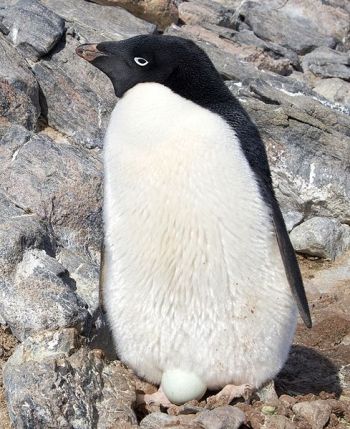 The Adelie penguin is considered Least Concern by the IUCN Red List. Photo by: Samuel Blanc. |
What is causing so many penguin populations to hit dangerously low levels? According to penguin-expert Dr. David G. Ainley, penguin populations are plummeting because of competition with humans. But not competition over space, like most species around the world, but over food. Put simply: the industrialized world is eating penguins to extinction.
“The main threat [to penguins] is depletion of fish by industrial fishing,” Ainley recently explained to mongabay.com, “and all penguin species except for the Antarctic ones, whose habitat so far is protected a bit by sea ice, have been seriously affected by this […] Penguins need lots of food, nearby, reliably available. It’s easy for fishing to negatively alter this,”
A marine biologist who has been studying penguins and other top marine predators for decades, Ainley has especially focused on the Adelie penguin: one of the minority of species that is not currently threatened. Ainley explains that this is because the Adelie penguin is native to Antarctica and outlying islands. Only four of the 18 penguin species breed on Antarctica, but they are by far the most popular species for the media.
“The Antarctic penguins are still very abundant and an appreciable number of reporters find there way to their areas. So, we get story after story after story about the penguins on the Antarctic Peninsula, to which lots of nature tours go, and little from elsewhere. Most of the other penguin species occur on offshore islands which are often harder to get to for the usual media story,” Ainley explains.
After industrial fishing, other threats include human destruction of breeding areas and climate change. However, Ainley explains, that for penguins climate change is currently much less disruptive than overfishing: “climate change can not hold a candle to the changes that industrial fishing has already wrought on the marine environment. That’s the inconvenient truth that even the climate change champions can’t admit.”
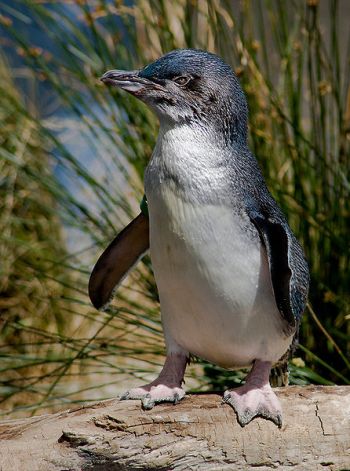 The world’s smallest penguin: the little penguin. |
But Ainley adds that climate change in combination with industrialized fishing will add greater pressure on penguins’ food sources.
“Changed wind patterns, affected upwelling, altered ocean temperature, and eventually greater acidification which will affect process way down in the food webs relative to where penguins occur in them,” he says.
As evidenced by a decline in penguin populations in most parts of the world: less food means fewer penguins.
“[Penguins’] very high energy needs make them very sensitive to food availability and other ecosystem processes that affect food,” Ainley explains. “It ‘costs’ a lot of energy to swim in the ocean, especially the cold ocean where penguins occur. Since they don’t fly, they are very poor at searching for food. Thus, it is very necessary for there to be a lot of food in known locations.”
Penguins’ role as top predators, their need for an abundant number of food sources to survive, and the ease with which researchers are able to study these birds, make them good ‘indicator species’ of how the oceans, and especially the marine food chain, is holding up. Unfortunately the indications are not good: Ainley says that the industrialized fishing has “simplified” marine food webs to the determent of penguins and many other marine animals.
One species of penguin is also threatened by the human drive for fossil fuels. Living on the southern coast of Africa, the African penguin (Spheniscus demersus) swims and feeds in one of the busiest oil shipping regions of the world. Two spills in the last two decades—1994 and 2000—killed a total of 30,000 penguins. However, the 2000 spill also resulted in the largest bird rescue ever: with tens of thousands of volunteers helping oiled and threatened birds survive. Like its relatives, the African penguin has also suffered from overfishing.
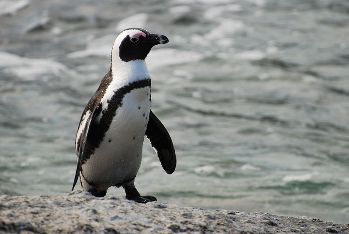 The African penguin is considered Vulnerable to extinction. Photo by: Paul Mannix. |
“Add to [the oil spills] the huge alteration of the Benguela Current, owing to fish depletion, and it is little wonder that this species is critically endangered,” says Ainley. He warns that other species of penguins may become threatened by oil spills as well.
“If drilling ever happens on Falklands Shelf—and this must be the reason that Argentina and UK went to war, i.e. for potential oil—then a number of penguin populations there would be vulnerable,” says Ainley.
Five species of penguin breed on the Falklands, more even than in Antarctica. An oil spill near these islands could be catastrophic for the world’s penguins. For now, though, the biggest threat to penguins globally remains industrial fishing.
Ainley says that people can help save the world’s penguins by “asking for the establishment of marine protected areas, which are the only way to control the fishing industry and prevent the ultimate complete depletion of Earth’s marine resources.”
In addition he asks penguin-lovers to avoid purchasing Chilean sea bass. The rapid decline of Chilean sea bass has affected everything from whales to seals to penguins. There have even been reports of fishermen dynamiting killer whales and sperm whales to kill their competition. The Monterey Bay Aquarium Seafood Watch program classifies this fish as one which consumers should avoid.
“As the penguins said in Happy Feet, which I thought to be a very good film, much more sophisticated and true than March of the Penguins: ‘STOP EATING OUR FISH!!!'” Ainley says.
Perhaps, the penguin’s popularity has proven a double-edged sword. Maybe their ubiquitous appearance in cartoons and children’s books, while making the birds universally popular have also given them the stigma of fancifulness; in other words, has it become difficult for the public to realize that penguins are flesh-and-blood animals which are fighting for survival, not just media stars? If we want penguins to remain more than happy doodles, it will require changes in our laws and behavior. But such changes would help our entire marine ecosystem, from the loveable penguins all down the food chain.
Penguin Species
Endangered:
Erect crested penguin ( Eudyptes sclateri)
Galapagos penguin (Spheniscus mendiculus)
Northern rockhopper penguin (Eudyptes moseleyi)
Yellow-eyed penguin (Megadyptes antipodes)
Vulnerable:
African penguin ( Spheniscus demersus)
Fiordland penguin (Eudyptes pachyrynchus)
Humboldt penguin (Spheniscus humboldti)
Macaroni penguin (Eudyptes chrysolophus)
Royal penguin (Eudyptes schlegeli)
Snares penguin (Eudyptes robustus)
Southern rockhopper penguin (Eudyptes chrysocome)
Near Threatened:
Gentoo penguin ( Pygoscelis papua)
Magellanic penguin ( Spheniscus magellanicus)
Least Concern:
Adelie penguin ( Pygoscelis adeliae)
Chinstrip penguin ( Pygoscelis antarctica)
Emperor penguin ( Aptenodytes forsteri)
King penguin (Aptenodytes patagonicus)
Little penguin ( Eudyptula minor)
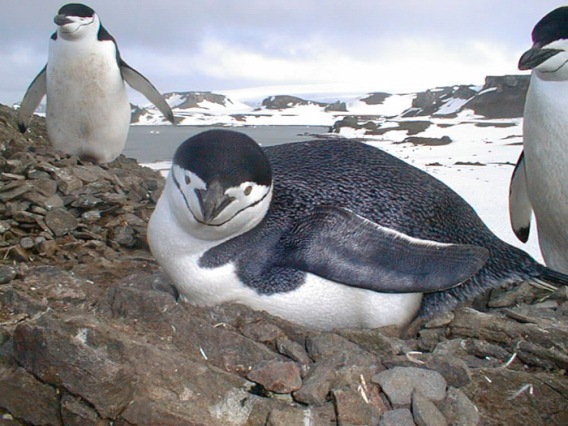
Chinstrip penguins. Photo by: NOAA/Mike Goebel.
Related articles
Rockhopper penguins benefit from new park in Argentina

(03/31/2010) Southern rockhopper penguins (Eudyptes chrysocome) are easily distinguished by the spiked plumes on their head, their neon-yellow eyebrows, and red eyes. But these wild-looking penguins are also endangered: the IUCN Red List classifies them as Vulnerable to extinction due to pollution and drowning by fishing nets.
Falklands Dispute: Argentine Sovereignty Won’t Solve the Problem

(03/15/2010) With Britain now moving to explore for oil and gas in the Falkland Islands, Argentina has cried foul. Buenos Aires claims that the Falklands, or the Malvinas as Argentines refer to the islands, represent a “colonial enclave” in the south Atlantic. The islands have been a British possession since 1833, and the local inhabitants consider themselves thoroughly British. Yet, Argentina claims the Malvinas as the country inherited them from the Spanish crown in the early 1800s. In 1982 Argentina seized the islands but was later expelled by a British naval force. The war was short but bloody, costing 650 Argentine and 250 British lives.
Photo: guano stains helps researchers track penguins by satellite

(06/10/2009) Researchers from the British Antarctic Survey (BAS) have uncovered a novel way to locate the world’s largest penguin’s breeding sites, employing satellite imagery they seek out Emperor penguin guano, droppings which show up starkly on the otherwise unsullied white sea ice of Antarctica. Searching for the penguins themselves had proven too difficult, since the birds’ black-and-white coloring allowed them to blend in with the shadows made by the ice. The penguin droppings however are light-brown—a colors that has no other source on sea ice, besides guano.
Studying world’s rarest penguin leads to the discovery of a new species
(11/19/2008) Researching one of the world’s most endangered penguins in New Zealand, the yellow-eyed penguin, has led to a remarkable discovery. DNA from 500-year-old penguin fossils has shown that the country was once home to not just one penguin species, but two. The DNA has resurrected an unknown extinct penguin, which researchers have named the Waitaha Penguin.
2-degree rise in temperature may doom penguins colonies
(10/10/2008) More than half Antarctica’s penguin colonies are at risk by a 2-degree global rise in temperatures, according to a report released by the environmental group WWF.
African penguin population drops 40% – cause unknown
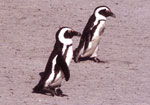
(03/02/2007) African penguin populations have fallen by 40 percent in the past few years according to an article published in the March 2, 2006 issue of Science. Biologists are puzzled by the decline.
The Scoop on Penguins – Feathered Fish or Bodacious Bird?
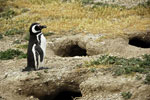
(02/28/2007) Penguins are birds that can toboggan on ice using their webbed feet to propel them. The fastest penguin, the gentoo, can swim about 15 miles per hour, faster than long-distance runners. Penguins can also dive very deep, some to depths of about 1,750 feet. They use their wings (which are really like flippers) to propel themselves in the water. It looks as if they are “flying” underwater, something they cannot do in the air.